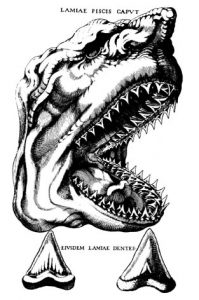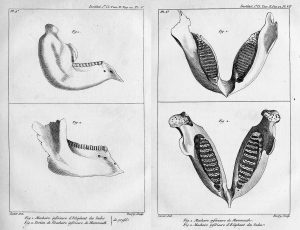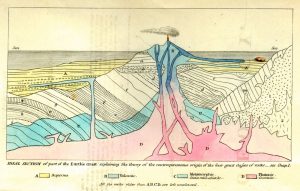1.4: Foundations of Modern Geology
- Page ID
- 6842
As part of the scientific revolution in Europe, modern geologic principles developed in the 17th and 18th centuries. One major contributor was Nicolaus Steno (1638-1686), a Danish priest who studied anatomy and geology. Steno was the first to propose the Earth’s surface could change over time. He suggested sedimentary rocks, such as sandstone and shale, originally formed in horizontal layers with the oldest on the bottom and progressively younger layers on top [20].

In the 18th century, Scottish naturalist James Hutton (1726–1797) studied rivers and coastlines and compared the sediments they left behind to exposed sedimentary rock strata. He hypothesized that ancient rocks must have been formed by processes like those producing the features in the oceans and streams. Hutton also proposed the Earth was much older than previously thought. Modern geologic processes operate slowly. Hutton realized if these processes formed rocks, then the Earth must be very old, possibly hundreds of millions of years old [21; 22].
Hutton’s idea is called the principle of uniformitarianism and states that natural processes operate the same now as in the past, i.e. the laws of nature are uniform across space and time. Geologists often state that “the present is the key to the past,” meaning they can understand ancient rocks by studying modern geologic processes.

Prior to the acceptance of uniformitarianism, scientists such as German geologist Abraham Gottlob Werner (1750-1817) and French anatomist Georges Cuvier (1769-1832) thought rocks and landforms were formed by great catastrophic events. Cuvier championed this view, known as catastrophism, and stated, “The thread of operation is broken; nature has changed course, and none of the agents she employs today would have been sufficient to produce her former works.” He meant processes that operate today did not operate in the past [21; 23]. Known as the father of vertebrate paleontology, Cuvier made significant contributions to the study of ancient life and taught at Paris’s Museum of Natural History. Based on his study of large vertebrate fossils, he was the first to suggest species could go extinct. However, he thought new species were introduced by special creation after catastrophic floods [21; 24].

Hutton’s ideas about uniformitarianism and Earth’s age were not well received by the scientific community of his time. His ideas were falling into obscurity when Charles Lyell, a British lawyer and geologist (1797-1875), wrote the Principles of Geology in the early 1830s and later, Elements of Geology [21, 25]. Lyell’s books promoted Hutton’s principle of uniformitarianism, his studies of rocks and the processes that formed them, and the idea that Earth was possibly over 300 million years old. Lyell and his three-volume Principles of Geology had a lasting influence on the geologic community and public at large, who eventually accepted uniformitarianism and millionfold age for the Earth [21]. The principle of uniformitarianism became so widely accepted, that geologists regarded catastrophic change as heresy. This made it harder for ideas like the sudden demise of the dinosaurs by asteroid impact to gain traction.
A contemporary of Lyell, Charles Darwin (1809-1882) took Principles of Geology on his five-year trip on the HMS Beagle [27]. Darwin used uniformitarianism and deep geologic time to develop his initial ideas about evolution. Lyell was one of the first to publish a reference to Darwin’s idea of evolution [28].
The next big advancement, and perhaps the largest in the history of geology, is the theory of plate tectonics and continental drift. Dogmatic acceptance of uniformitarianism inhibited the progress of this idea, mainly because of the permanency placed on the continents and their positions. Ironically, the slow and steady movement of plates would fit well into a uniformitarianism model. However, much time passed and a great deal of scientific resistance had to be overcome before the idea took hold. This happened for several reasons. Firstly, the movement was so slow it was overlooked. Secondly, the best evidence was hidden under the ocean. Finally, the accepted theories were anchored by a large amount of inertia. Instead of being bias-free, scientists resisted and ridiculed the emerging idea of plate tectonics. This example of dogmatic thinking is still to this day a tarnish on the geoscience community.
Plate tectonics is most commonly attributed to Alfred Wegener, the first scientist to compile a large data set supporting the idea of continents shifting places over time. He was mostly ignored and ridiculed for his ideas, but later workers like Marie Tharp, Bruce Heezen, Harry Hess, Laurence Morley, Frederick Vine, Drummond Matthews, Kiyoo Wadati, Hugo Benioff, Robert Coats, and J. Tuzo Wilson benefited from advances in subsea technologies. They discovered, described, and analyzed new features like the mid-ocean ridge, alignment of earthquakes, and magnetic striping. Gradually these scientists introduced a paradigm shift that revolutionized geology into the science we know today.

References
- 20. Paradowski, R. J. Nicolas Steno: Danish anatomist and geologist. Great Lives from History: Scientists & Science 830–832 (2012).
- 21. Repcheck, J. The Man Who Found Time : James Hutton and the Discovery of the Earth’s Antiquity. (New York: Basic Books., 2009).
- 22. Rappaport, R. James Hutton and the History of Geology. Dennis R. Dean. Isis 85, 524–525 (1994).
- 23. Van Reybrouck, D. From Primitives to Primates: A History of Ethnographic and Primatological Analogies in the Study of Prehistory. (Sidestone Press, 2012).
- 24. Kolbert, E. The sixth extinction: an unnatural history. (Henry Holt and Co., 2014).
- 25. Porter, R. Charles Lyell and the Principles of the History of Geology. Br. J. Hist. Sci. 9, 91–103 (1976).
- 27. Darwin, C. Geological Observations on South America: Being the Third Part of the Geology of the Voyage of the Beagle, Under the Command of Capt. Fitzroy, R.N. During the Years 1832 to 1836. (Smith, Elder and Company, 1846).
- 28. Mayr, E. Systematics and the Origin of Species, from the Viewpoint of a Zoologist. (Harvard University Press, 1942).


